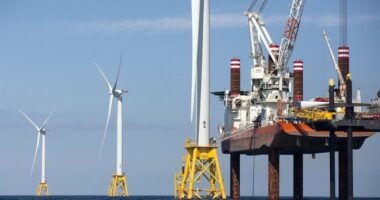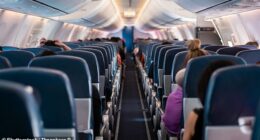Australia’s economy is barely growing despite record-high immigration levels and generous electricity rebates from the federal government.
The nation’s gross domestic product grew by just 0.8 per cent in the year to September.
This was Australia’s weakest level of economy activity since the 1991 recession outside of a pandemic, with borrowers missing out on any relief from the Reserve Bank.
Australia also continues to be a per capita recession where output for every Australian has been going backwards while workplace productivity is in decline.
Treasurer Jim Chalmers blamed the cost-of-living crisis for Australia’s weak economic activity, with economists not expecting any interest rate cut soon.
‘Today’s National Accounts confirm that growth in the Australian economy continues to be positive but weak,’ he said.
‘Our economy is growing but very slowly, weighed down by interest rates, cost of living pressures and global uncertainty.’
The 0.8 per cent annual growth pace was well below Commonwealth Bank expectations of a 1.1 per cent increase and was also only a fraction of the three-decade average of 3 per cent.

Australia’s economy is still barely growing despite record-high immigration levels (pictured is Sydney’s Pitt Street Mall)
The Australian Bureau of Statistics data showed GDP per capita shrank by 1.5 per cent over the year, continuing a per capita recession that began in early 2023 with September marking the seventh straight quarter of decline.
Australia is not yet in a technical recession – defined as two consecutive quarters of GDP going backwards.
But the economy grew by just 0.3 per cent in the September quarter.
Productivity fell by 0.5 per cent over the same three-month period.
Dr Chalmers argued Australia’s economic growth would have been even weaker without Labor’s electricity and childcare rebates.
‘Australians would be much worse off and growth would be even weaker without our responsible approach to the Budget and our cost-of-living support,’ he said.
Moody’s Analytics economist Harry Murphy Cruise said Australians were pocketing their government rebates and tax cuts instead of spending them.
‘Households chose not to loosen the purse strings; instead, they funnelled the savings into bank accounts and paid down mortgages,’ he said.

The nation’s gross domestic product grew by just 0.8 per cent in the year to September (pictured is Prime Minister Anthony Albanese)
‘The Aussie economy remains in the slow lane as sky-high borrowing costs and structurally higher prices zap spending.’
The historically weak economic activity has also coincided with record-high immigration levels.
In the year to March, 509,800 migrants on a net basis moved to Australia.
Australia’s population grew by 2.3 per cent – a level almost triple Australia’s very weak 0.8 per cent annual economic growth pace.
Immigration has barely slowed, with 449,060 migrants moving to Australia in the year to September – despite Treasury’s May Budget forecasting a slowdown to just 260,000 in 2024-25.
Australia’s underlying inflation rate in September was still high at 3.5 per cent – or at a level well above the Reserve Bank’s 2 to 3 per cent target when the effects of $300 electricity rebates were excluded.
Services inflation is even higher at 4.6 per cent.
Dr Chalmers also blamed state government spending for fuelling inflation – after Reserve Bank Governor Michele Bullock last month again suggested state and federal government spending was keeping inflation high.

Treasurer Jim Chalmers blamed the cost-of-living crisis for Australia’s weak economic activity, with economists not expecting any interest rate cut soon
‘State and local spending represented 60 per cent of public demand growth in the quarter,’ the Treasurer said.
‘There was also some support from our responsible cost-of-living relief and demand-driven spending on services that Australians rely on like the NDIS and aged care.’
In another sign of a slow economy, vehicle sales in November were 11.6 per cent weaker compared with November 2023.
The Federal Chamber of Automotive Industries data also revealed a 16.6 per cent annual plunge in private buyer activity, with chief executive Tony Weber noting Australian families were putting off buying a new car.
‘This is a disturbing trend which illustrates how cost of living pressures are impacting households,’ he said.
Top-selling utes are now struggling to attract the same level of customer interest, with Ford Ranger sales falling by 20.9 per cent as Toyota HiLux sales dived 39.5 per cent and Isuzu D-Max sales dropped 41 per cent.
The Reserve Bank has ruled out a rate cut in 2024, with the RBA board meeting next week.
The futures market sees no rate cut occurring until May next year – a view shared by economists at Westpac, ANZ and NAB.
‘The Aussie economy will remain sluggish until interest rates come down. Despite progress on inflation, that first cut still looks a little while off,’ Mr Murphy Cruise said.
Australian borrowers are missing out on relief even though central banks in the U.S., UK, Canada, European Union and New Zealand have this year already cut interest rates several times.
The RBA’s 13 interest rate rises in 2022 and 2023 took the cash rate to 4.35 per cent and marked the most aggressive pace of monetary policy tightening since the late 1980s.
Prime Minister Anthony Albanese’s re-election is more challenging during a cost-of-living crisis that has seen a population-fuelled increase in rents and soaring mortgage repayments.






